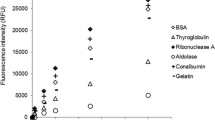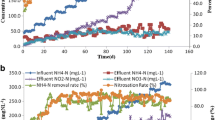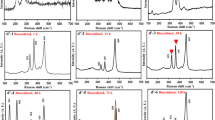Abstract
Biofilms are surface-associated colonies of microorganisms embedded in a matrix of extracellular polymeric substances (EPS). As EPS mediate the contact between cells and surfaces, an understanding of their composition and production is of particular interest. In this study, the EPS components of Sulfolobus metallicus DSM 6482T forming biofilms on elemental sulfur (S0) were investigated by confocal laser scanning microscopy (CLSM). In order to visualize cell and EPS distributions, biofilm cells were stained with various dyes specific for glycoconjugates, proteins, nucleic acids and lipids. Biofilm cells on S0 were heterogeneously distributed and characterized as individual cells, microcolonies, and large clusters up to a hundred micrometers in diameter. The glycoconjugates in biofilms were detected by fluorescence lectin-binding analysis (FLBA). Screening of 72 commercially available lectins resulted in the selection of 21 lectins useful for staining biofilms of S. metallicus T. Capsular EPS from planktonic cells were mainly composed of carbohydrates and proteins. In contrast, colloidal EPS from planktonic cells were dominated by carbohydrates. Proteins were found to be major components in EPS from biofilms on S0. Using specific probes combined with CLSM, we showed that extracellular proteins and nucleic acids were present in the EPS matrix. Finally, we showed that S. metallicus T cells were embedded in a flexible EPS matrix. This study provides new insights into archaeal biofilms and EPS composition and properties with respect to their interactions with S0.








Similar content being viewed by others
References
Albers S-V, Meyer BH (2011) The archaeal cell envelope. Nat Rev Microbiol 9:414–426
Arredondo R, García A, Jerez CA (1994) Partial removal of lipopolysaccharide from Thiobacillus ferrooxidans affects its adhesion to solids. Appl Environ Microbiol 60:2846–2851
Becker T, Gorham N, Shiers D, Watling H (2011) In situ imaging of Sulfobacillus thermosulfidooxidans on pyrite under conditions of variable pH using tapping mode atomic force microscopy. Process Biochem 46:966–976
Beebe JL, Umbreit W (1971) Extracellular lipid of Thiobacillus thiooxidans. J Bacteriol 108:612–614
Bellenberg S, Leon-Morales C-F, Sand W, Vera M (2012) Visualization of capsular polysaccharide induction in Acidithiobacillus ferrooxidans. Hydrometallurgy 129:82–89
Blais J-F, Tyagi R, Meunier N, Auclair J (1994) The production of extracellular appendages during bacterial colonization of elemental sulphur. Process Biochem 29:475–482
Boretska M, Bellenberg S, Moshynets O, Pokholenko I, Sand W (2013) Change of extracellular polymeric substances composition of Thiobacillus thioparus in presence of sulfur and steel. J Microb Biochem Technol 5:68–73
Bradford MM (1976) A rapid and sensitive method for the quantitation of microgram quantities of protein utilizing the principle of protein-dye binding. Anal Biochem 72:248–254
Brockmann S, Arnold T, Schweder B, Bernhard G (2010) Visualizing acidophilic microorganisms in biofilm communities using acid stable fluorescence dyes. J Fluoresc 20:943–951
Bryant R, Costerton J, Laishley E (1984) The role of Thiobacillus albertis glycocalyx in the adhesion of cells to elemental sulfur. Can J Microbiol 30:81–90
Burton K (1956) A study of the conditions and mechanism of the diphenylamine reaction for the colorimetric estimation of deoxyribonucleic acid. Biochem J 62:315–323
Castro L, Zhang R, Muñoz JA, González F, Blázquez ML, Sand W, Ballester A (2014) Characterization of exopolymeric substances (EPS) produced by Aeromonas hydrophila under reducing conditions. Biofouling 30:501–511
Dominiak DM, Nielsen JL, Nielsen PH (2011) Extracellular DNA is abundant and important for microcolony strength in mixed microbial biofilms. Environ Microbiol 13:710–721
Dopson M, Johnson DB (2012) Biodiversity, metabolism and applications of acidophilic sulfur-metabolizing microorganisms. Environ Microbiol 14:2620–2631
Dubois M, Gilles KA, Hamilton JK, Rebers P, Smith F (1956) Colorimetric method for determination of sugars and related substances. Anal Chem 28:350–356
Dutrizac J (1990) Elemental sulphur formation during the ferric chloride leaching of chalcopyrite. Hydrometallurgy 23:153–176
Ellen AF, Albers S-V, Driessen AJ (2010) Comparative study of the extracellular proteome of Sulfolobus species reveals limited secretion. Extremophiles 14:87–98
Flemming H-C, Wingender J (2010) The biofilm matrix. Nat Rev Microbiol 8:623–633
Flemming H-C, Neu TR, Wozniak DJ (2007) The EPS matrix: the “house of biofilm cells”. J Bacteriol 189:7945–7947
Fröls S (2013) Archaeal biofilms: widespread and complex. Biochem Soc Trans 41:393–398
Ghorbani Y, Petersen J, Harrison ST, Tupikina OV, Becker M, Mainza AN, Franzidis J-P (2012) An experimental study of the long-term bioleaching of large sphalerite ore particles in a circulating fluid fixed-bed reactor. Hydrometallurgy 129:161–171
Harneit K, Göksel A, Kock D, Klock J-H, Gehrke T, Sand W (2006) Adhesion to metal sulfide surfaces by cells of Acidithiobacillus ferrooxidans, Acidithiobacillus thiooxidans and Leptospirillum ferrooxidans. Hydrometallurgy 83:245–254
Henche AL, Koerdt A, Ghosh A, Albers SV (2012) Influence of cell surface structures on crenarchaeal biofilm formation using a thermostable green fluorescent protein. Environ Microbiol 14:779–793
Jarrell KF, Albers S-V (2012) The archaellum: an old motility structure with a new name. Trends Microbiol 20:307–312
Jarrell KF, Ding Y, Meyer BH, Albers S-V, Kaminski L, Eichler J (2014) N-linked glycosylation in Archaea: a structural, functional, and genetic analysis. Microbiol Mol Biol Rev 78:304–341
Kletzin A (2008) Oxidation of sulfur and inorganic sulfur compounds in Acidianus ambivalens. In: Dahl C, Friedrich CG (Eds) Microbial sulfur metabolism. Springer, Heidelberg, pp 184-201
Knickerbocker C, Nordstrom D, Southam G (2000) The role of “blebbing” in overcoming the hydrophobic barrier during biooxidation of elemental sulfur by Thiobacillus thiooxidans. Chem Geol 169:425–433
Koerdt A, Gödeke J, Berger J, Thormann KM, Albers S-V (2010) Crenarchaeal biofilm formation under extreme conditions. PLoS One 5:e14104
Koerdt A, Orell A, Pham TK, Mukherjee J, Wlodkowski A, Karunakaran E, Biggs CA, Wright PC, Albers S-V (2011) Macromolecular fingerprinting of Sulfolobus species in biofilm: a transcriptomic and proteomic approach combined with spectroscopic analysis. J Proteome Res 10:4105–4119
Koerdt A, Jachlewski S, Ghosh A, Wingender J, Siebers B, Albers S-V (2012) Complementation of Sulfolobus solfataricus PBL2025 with an α-mannosidase: effects on surface attachment and biofilm formation. Extremophiles 16:115–125
Little B, Ray R, Pope R (2000) Relationship between corrosion and the biological sulfur cycle: a review. Corrosion 56:433–443
Liu H-C, Xia J-L, Nie Z-Y, Peng A-A, Ma C-Y, Zheng L, Zhao Y-D (2013) Comparative study of sulfur utilization and speciation transformation of two elemental sulfur species by thermoacidophilic Archaea Acidianus manzaensis YN-25. Process Biochem 48:1855–1860
Mackintosh ME (1978) Nitrogen fixation by Thiobacillus ferrooxidans. J Gen Microbiol 105:215–218
Mangold S, Harneit K, Rohwerder T, Claus G, Sand W (2008) Novel combination of atomic force microscopy and epifluorescence microscopy for visualization of leaching bacteria on pyrite. Appl Environ Microbiol 74:410–415
Meyer BH, Albers S-V (2013) Hot and sweet: protein glycosylation in Crenarchaeota. Biochem Soc Trans 41:384–392
Naumann D, Helm D, Labischinski H (1991) Microbiological characterizations by FT-IR spectroscopy. Nature 351:81–82
Neu TR, Swerhone GD, Lawrence JR (2001) Assessment of lectin-binding analysis for in situ detection of glycoconjugates in biofilm systems. Microbiology 147:299–313
Ng F-W, Dawes E (1973) Chemostat studies on the regulation of glucose metabolism in Pseudomonas aeruginosa by citrate. Biochem J 132:129–140
Nichols PD, Michael Henson J, Guckert JB, Nivens DE, White DC (1985) Fourier transform-infrared spectroscopic methods for microbial ecology: analysis of bacteria, bacteri-polymer mixtures and biofilms. J Microbiol Methods 4:79–94
Nie Z-Y, Liu H-C, Xia J-L, Zhu H-R, Ma C-Y, Zheng L, Zhao Y-D, Qiu G-Z (2014) Differential utilization and transformation of sulfur allotropes, μ-S and α-S8, by moderate thermoacidophile Sulfobacillus thermosulfidooxidans. Res Microbiol 165:639–646
Okshevsky M, Meyer RL (2013) The role of extracellular DNA in the establishment, maintenance and perpetuation of bacterial biofilms. Crit Rev Microbiol 1-11
Orell A, Fröls S, Albers S-V (2013) Archaeal biofilms: the great unexplored. Annu Rev Microbiol 67:337–354
Parikh SJ, Chorover J (2006) ATR-FTIR spectroscopy reveals bond formation during bacterial adhesion to iron oxide. Langmuir 22:8492–8500
Peng AA, Xia JL, Liu HC, Zhu W, Zhang RY, Zhang CG, Nie ZY (2013) Thiol-rich proteins play important role in adhesion and sulfur oxidation process of Acidithiobacillus ferroxidans. Adv Mater Res 825:137–140
Rodrıguez Y, Ballester A, Blazquez M, Gonzalez F, Munoz J (2003) New information on the chalcopyrite bioleaching mechanism at low and high temperature. Hydrometallurgy 71:47–56
Rohwerder T, Sand W (2003) The sulfane sulfur of persulfides is the actual substrate of the sulfur-oxidizing enzymes from Acidithiobacillus and Acidiphilium spp. Microbiology 149:1699–1710
Rohwerder T, Sand W (2007) Oxidation of inorganic sulfur compounds in acidophilic prokaryotes. Eng Life Sci 7:301–309
Sand W (1985) The influence of four detergents on the substrate oxidation by Thiobacillus ferrooxidans. Environ Technol 6:439–444
Sand W, Gehrke T, Hallmann R, Schippers A (1998) Towards a novel bioleaching mechanism. Miner Process Extr Metall Rev 19:97–106
Schmitt J, Flemming H-C (1998) FTIR-spectroscopy in microbial and material analysis. Int Biodeterior Biodegrad 41:1–11
Staudt C, Horn H, Hempel D, Neu T (2003) Screening of lectins for staining lectin-specific glycoconjugates in the EPS of biofilms. In: Lens P, O’Flaherty V, Moran AP, Stoodley P, Mahony T (eds) Biofilms in medicine, industry and environmental technology. IWA Publishing, London, pp 308–327
Stoodley P, Sauer K, Davies D, Costerton JW (2002) Biofilms as complex differentiated communities. Annu Rev Microbiol 56:187–209
Suci P, Siedlecki K, Palmer R, White D, Geesey G (1997) Combined light microscopy and attenuated total reflection fourier transform infrared spectroscopy for integration of biofilm structure, distribution, and chemistry at solid-liquid interfaces. Appl Environ Microbiol 63:4600–4603
Takeuchi TL, Suzuki I (1997) Cell hydrophobicity and sulfur adhesion of Thiobacillus thiooxidans. Appl Environ Microbiol 63:2058–2061
Umbreit W, Vogel H, Vogler K (1942) The significance of fat in sulfur oxidation by Thiobacillus thiooxidans. J Bacteriol 43:141–148
Vera M, Krok B, Bellenberg S, Sand W, Poetsch A (2013a) Shotgun proteomics study of early biofilm formation process of Acidithiobacillus ferrooxidans ATCC 23270 on pyrite. Proteomics 13:1133–1144
Vera M, Schippers A, Sand W (2013b) Progress in bioleaching: fundamentals and mechanisms of bacterial metal sulfide oxidation—part A. Appl Microbiol Biotechnol 97:7529–7541
Weiss R (1973) Attachment of bacteria to sulphur in extreme environments. J Gen Microbiol 77:501–507
Whitchurch CB, Tolker-Nielsen T, Ragas PC, Mattick JS (2002) Extracellular DNA required for bacterial biofilm formation. Science 295:1487–1487
Zhang C-G, Xia J-L, Zhang R-Y, Peng A-A, Nie Z-Y, Qiu G-Z (2008a) Comparative study on effects of Tween-80 and sodium isobutyl-xanthate on growth and sulfur-oxidizing activities of Acidithiobacillus albertensis BY-05. T Nonferr Metal Soc 18:1003–1007
Zhang C-G, Zhang R-Y, Xia J-L, Zhang Q, Z-Y NIE (2008b) Sulfur activation-related extracellular proteins of Acidithiobacillus ferrooxidans. T Nonferr Metal Soc 18:1398–1402
Zhang R, Bellenberg S, Castro L, Neu TR, Sand W, Vera M (2014) Colonization and biofilm formation of the extremely acidophilic archaeon Ferroplasma acidiphilum. Hydrometallurgy 150:245–252
Zhang RY, Neu TR, Bellenberg S, Kuhlicke U, Sand W, Vera M (2015) Use of lectins to in situ visualize glycoconjugates of extracellular polymeric substances in acidophilic archaeal biofilms. Microb Biotechnol 8:448–461
Zippel B, Neu T (2011) Characterization of glycoconjugates of extracellular polymeric substances in tufa-associated biofilms by using fluorescence lectin-binding analysis. Appl Environ Microbiol 77:505–516
Zolghadr B, Klingl A, Koerdt A, Driessen AJ, Rachel R, Albers S-V (2010) Appendage-mediated surface adherence of Sulfolobus solfataricus. J Bacteriol 192:104–110
Acknowledgments
We thank Dr. Supratim Banerjee (Institute of Organic Chemistry, Universität Duisburg-Essen) for the help of FTIR measurements. R. Z. acknowledges China Scholarship Council (CSC) for financial support (no. 2010637124).
Conflict of interest
The authors declare that they have no competing interests.
Author information
Authors and Affiliations
Corresponding author
Rights and permissions
About this article
Cite this article
Zhang, R., Neu, T.R., Zhang, Y. et al. Visualization and analysis of EPS glycoconjugates of the thermoacidophilic archaeon Sulfolobus metallicus . Appl Microbiol Biotechnol 99, 7343–7356 (2015). https://doi.org/10.1007/s00253-015-6775-y
Received:
Revised:
Accepted:
Published:
Issue Date:
DOI: https://doi.org/10.1007/s00253-015-6775-y




